Little Blue Birdie’s Diary
At the Hiroshima Castle
Dear Diary,
After the Vesak celebrations, here I’m back with my journal,
heavy-hearted because of my grandfather’s death. It’s been almost a
month, but I still couldn’t get over it. I just can’t believe that he is
no more.
Memories of him float in my mind when I write this journal because he
is the one who encouraged me to fly around the world and write a travel
journal. After his death, while going through his belongings, I found my
well-preserved journals in his locker.
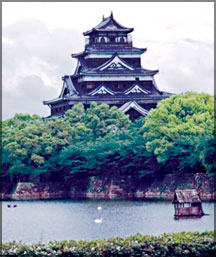
After reading my journal entry, his usual question will be “So, where
will you fly next week?” Now, many days and weeks have passed, but no
one has asked me where I will go next week. That is when I really feel
the loss of my grandfather; I miss the encouragement he used to give me.
The only thing I can do is to wish that he attains Nibbana!
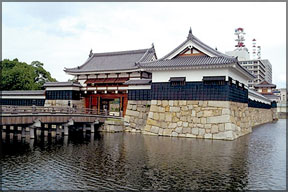
After Vesak, we flew to Japan to bring you details about more
landmarks in that country. I hope you remeber our visits to the Tokyo
Tower and other places in Japan when we were here last time. Today we
visited the Hiroshima Castle. First, let me tell you about the history
of this castle.
Hiroshima Castle, sometimes called Carp Castle is in Hiroshima, and
was the home of the daimyo (feudal lord) of Hiroshima. Originally
constructed in the 1590s, the castle was destroyed in the atomic bombing
in 1945. It was rebuilt in 1958, a replica of the original, and now
serves as a museum of Hiroshima’s history prior to World War II.
|
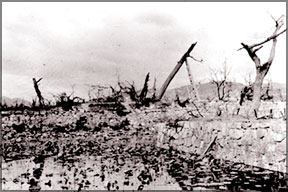
How the site looked after the atomic bombing in 1945 |
Mori Terumoto, one of Toyotomi Hideyoshi’s Council of Five Elders,
established the castle in 1589 at the delta of the Otagawa River. There
was no Hiroshima city or town at the time, and the area was called
Gokamura, meaning ‘five villages’.
Beginning in 1591, Mori governed nine provinces from this castle,
including much of what is now Shimane, Yamaguchi, Tottori, Okayama and
Hiroshima Prefectures (an administrative area). When construction of the
castle began, Gokamura was renamed Hiroshima, as a more impressive name
was called for.
‘Hiro’ was taken from oe no Hiromoto, an ancestor of the Mori family,
and ‘Shima’ was taken from Fukushima Motonaga who helped Mori Terumoto
to choose the castle site. Some accounts state that the name
‘Hiroshima’, which literally means ‘wide island’, comes from the
existence of several large islands in the delta of the Otagawa, near the
castle site.
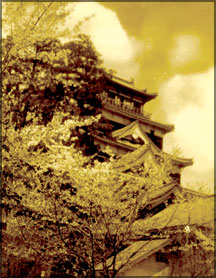
Following the battle of Sekigahara in 1600, Mori was forced out of
the castle, from where he retreated to Hagi in today’s Yamaguchi
Prefecture. Fukushima Masanori became the lord of Aki and Bingo
provinces (which today comprise the Hiroshima Prefecture), and of
Hiroshima Castle.
However, the new Tokugawa shogunate (form of government where the
ruler is a dictator) forbade any castle construction without permission;
this was part of how the shogunate kept the daimyo from gaining power
and overthrowing the shogunate.
When Fukushima repaired the castle following a flood in 1619, he was
dispatched to Kawanakajima in today’s Nagano Prefecture and Asano
Nagaakira became lord of the castle.
From 1619 until the abolition (doing away with) of the feudal system
during the Meiji Restoration (1869), the Asano family members were lords
of the Aki and Bingo provinces.
After the Meiji Restoration, the castle came to serve as a military
facility, and the Imperial General Head Quarters (GHQ) was based there
during the First Sino-Japanese War in 1894-1895.
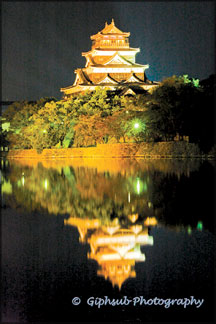
The foundations of several of the GHQ outbuildings, just a few
hundred paces from the castle’s main tower, remain today. The castle was
destroyed in the atomic bomb blast of August 6, 1945.
The present tower, constructed largely of concrete, was completed in
1958. The castle was originally constructed in wood, pine primarily, and
had attached wings to the east and to the south. It had been completed
sometime between 1592 and 1599, and had been designated a National
Treasure in 1931.
The reconstructed castle features the main tower (tenshu) only, which
is made primarily of reinforced concrete. Its five floors stand 26.6
metres above the stone foundation which, in turn, is 12.4 metres high
off the ground. However, in recent years, a gate and a yagura (tower)
have been re-constructed out of wood using the original methods.
An excellent example of a hirajiro or flatlands (plains) castle,
Hiroshima Castle once had three concentric (with the same centre) moats
in addition to the Otagawa River to the west (now called the Hongawa),
which provided an additional natural barrier.
Bye for now. |
